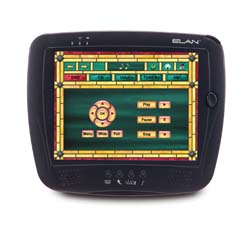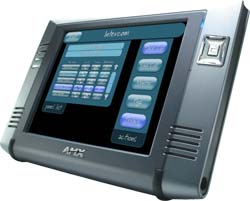Saving (Inter)Face

- Not so long ago, control interfaces were considered sophisticated if users could perform simple functions, such as turn a DVD player on or off. As manufacturers include more features in their systems, however, end-users are catching on that their GUI's are capable of doing so much more.
Crestron Electronics's UPX-2 presentation system incorporates PC functionality, video switching, scaling, and annotation capabilities in a central unit.
"Today's functionality could range from the ability to use PC software applications such as Microsoft Office, to displaying and freezing live video feeds on demand, annotating over them and exporting data or meeting notes, that can be both posted to a web page or distributed afterwards," noted Josh Stene, technical director at Crestron Electronics in Orlando, FL. The company's UPX-2 presentation system-which incorporates PC functionality, video switching, scaling, and annotation capabilities in a central unit-is one such example.
Robert Noble, vice president of product management at AMX Corporation in Richardson, TX, noted that standardization across large organizations has become a high priority for the IT departments within these institutions. "What many of the larger companies are wrestling with is how to be in one of their conference rooms on the East Coast, West Coast, or in Europe, and know how to use the system? How do they get consistency? Does the same button always turn the projector on? Turn on the lights? Or, will they have to re-learn every room they visit?" he illustrated. "Many companies are putting a lot of thought into this standardization, even going so far as to create a set of icons that are accepted across the organization, so that there is no language barrier."
To address consistency, Noble adds, AMX's systems enable programmers to achieve this. "We give them the tools to be able to do that-whether they are design pieces to create custom touchpanel pages, or the ability to make a touchpanel multilingual," he said. A system can be designed in different languages falling under one umbrella, allowing the user to select the preferred language themselves.
Noble emphasizes that as an increasing number of users turn their attention to standardization, manufacturers must step up to the plate. "We will be creating more tools to enable companies to standardize, so that they can create their own standard set of templates and designs that they can manage themselves, and deploy and engineer, so that they can take control of their own destiny rather than be so dependent on an outside source," he said.
Part of this thrust toward consistency could be attributed to the end-user's desire for cost-effective systems. As users are becoming better acquainted with the technology, they want confirmation that they are receiving a sound return on investment. "There is more sensitivity to the total cost of ownership for their control system interface-their software. Control systems, five years ago, were viewed as these turnkey solutions, where today they are being viewed as equipment software," said Bob Kranson, president and principal at Axiom Design in Pleasanton, CA. "As a result of that, there is a software element to this. Corporate buyers are sensitive to the cost. They aren't necessarily looking for something cheaper, but they are looking at what the total cost of ownership is going to be for that software."
David Moore, product line manager, for user interfaces and integration at Elan Home Systems in Lexington, KY, noted that the decreasing cost of touchpanels has made these systems more accessible to a wider marketplace. "The landscape has changed with respect to the price point," he pointed out. "Touchpanels used to be a $5,000 product, and now you can get a nice, high-end touchpanel for $800 retail. Now that price points have come down, the face of user interfaces is changing."
Kranson underlines that while it's the technology that enables programmers to devise creative and intuitive interfaces for their clients, the end goal is to develop a product that results in a positive user experience. "The solution has to be more about how the client is going to interact with it, rather than having it just be about the equipment itself," he said. "It's about the experience more than the technology."
A daily selection of the top stories for AV integrators, resellers and consultants. Sign up below.
The visuals that end-users come into contact with during the daily course of life have influenced how they want their interfaces to be designed. "They want graphically rich interfaces that are simple and easy to understand," Stene said. "Today, people are used to the web and what they see on their PCs, and they want that type of graphical richness that they are viewing elsewhere." He added that GUI developers should pay attention to elements such as color contrasting: "Colors should complement one another while maintaining the contrast for legibility. This is a common problem, especially for text in between button states. If there are very subtle differences between various states, it makes the end-user's experience a poor one."
In many cases, graphic artists are enlisted to ensure that the control interface is visually effective. "Many people are going to outside sources," Stene observed. In response to this, manufacturers are working on ways to make interface design more seamless for programmers. "We are developing more tools for our software application that allow programmers to more easily develop these graphically rich environments without adding exponential amounts of programming time to the project."
The information on a touchpanel should be easily accessible, Stene emphasized. "Clients don't want to tunnel down through multiple layers to get to the function that they want. Everything should be easy to understand, and within a few button presses you should be able to get the exact information and control functionality that you want," he said. "The interface should look good while allowing complete novices to feel comfortable using that technology."
As the technology progresses, the line between touchpanels and PCs is becoming blurred. "Crestron has deployed an entire line of these high-bred interfaces that incorporate not only basic control over traditional audiovisual gear, but also give the client access to many of the popular software applications, such as Microsoft Internet Explorer and Microsoft Office," Stene pointed out.
While the construction industry is experiencing a slight slowdown, Moore acknowledges that wireless interfaces provide dealers with solid solutions for retrofits. "If there isn't a large upswing over the next several years, the retrofit world will be a very lucrative direction for our dealers to go in, and wireless solutions are going to be paramount for a lot of these buildings where wire is not available," he said.
Pointing to the mobile phone industry, Stene observes that a touchpanel will not remain just a touchpanel for long. "I envision interfaces incorporating many new and diverse technologies. In the past, a cell phone was just a phone; today, cell phones are receiving streaming broadcasts and making movies," he reflected. "If we carry that type of thinking over to control and touchpanels, we, as manufacturers, have to analyze the day-to-day lives of our clients and then apply that technology so that it simplifies many of those everyday tasks."
AMX Corporation...www.amx.com
Axiom Design...www.axiomdesign.com
Crestron Electronics...www.crestron.com
Elan Home Systems...www.elanhomesystems.com
MARGIN BUILDERS
Part of the thrust toward consistency is the end-user's desire for cost-effective systems. As users are becoming better acquainted with the technology, they want confirmation that they are receiving a sound return on investment. "There is more sensitivity to the total cost of ownership for their control system interface-their software. Control systems, five years ago, were viewed as these turnkey solutions, where today they are being viewed as equipment software," said Bob Kranson, president and principal at Axiom Design in Pleasanton, CA. "As a result of that, there is a software element to this. Corporate buyers are sensitive to the cost. They aren't necessarily looking for something cheaper, but they are looking at what the total cost of ownership is going to be for that software."

Elan's VIA!2 Wireless Touchpanel
The VIA!2, the newest member of Elan Home Systems' line of VIA! panels, is an 8.4-inch LCD color touchpanel providing wireless control. It features a high-brightness screen and offers easy navigation and control for all installed compatible audio and video home entertainment products, as well as lighting, temperature, motorized screens, drapes, and security devices. The interface format also features customizable screen layouts with large, easy-to-read buttons and text for intuitive control of all systems. Additionally, the VIA!2 is customizable, offering a wide variety of stunning screen motifs that the homeowner can choose from in order to personalize the look and feel of the display to match individual tastes and room décors.

The AMX MVP-8400i Modero ViewPoint Touchpanel
The intercom-enabled MVP-8400i Modero ViewPoint touchpanel from AMX utilizes VoIP technology to give users the ability to instantly create a high-quality, digital home/office intercom network with no additional equipment required. By utilizing VoIP intercom, system integration is simple and calls sound incredibly clear.In addition to the already rich Modero touchpanel feature set, this panel also includes telephone voice quality audio, expanded memory and enhanced touch sensitivity. The MVP-8400i ships with touchpanel pages for intercom functionality included. All the system integrator needs to do is configure the system to meet individual customer needs and preferences. Additional options include enabling monitoring capabilities and privacy options for each, as well as whether or not panel-to-panel intercom calls should be automatically accepted or accepted only via a pop-up window on the panel.
Carolyn Heinze has covered everything from AV/IT and business to cowboys and cowgirls ... and the horses they love. She was the Paris contributing editor for the pan-European site Running in Heels, providing news and views on fashion, culture, and the arts for her column, “France in Your Pants.” She has also contributed critiques of foreign cinema and French politics for the politico-literary site, The New Vulgate.
